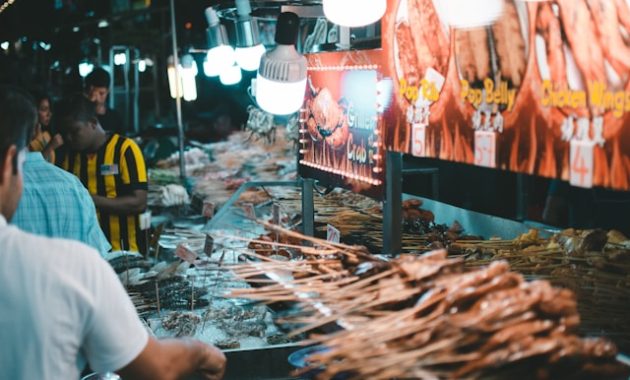
When it comes to exploring the culinary wonders of Southeast Asia, few destinations can compete with the vibrant, flavorful offerings found on the streets of Malaysia. Known for its bustling markets, aromatic spices, and multicultural influences, Malaysian street food offers a sensory experience unlike any other. In this guide, we’ll take you on a journey through some of the best street eats in Malaysia, covering the history, must-try dishes, and insider tips for enjoying these culinary treasures.
The Rich Tapestry of Malaysian Street Food Culture
Malaysian cuisine is a melting pot of Malay, Chinese, and Indian influences, each contributing its unique flavors, spices, and cooking techniques. This blending of cultures has created a street food paradise that is not only delicious but also highly diverse. From the bustling streets of Kuala Lumpur to the charming alleys of Penang, each region in Malaysia offers something unique, reflecting the local history and cultural richness.
Malaysian street food stalls, known locally as “warungs” or “hawker stalls,” are often modest setups, but they deliver a range of dishes that are bold, complex, and memorable. These eateries prioritize freshness and flavor, making them the go-to option for locals and tourists alike.
Must-Try Malaysian Street Foods
1. Char Kway Teow
One of the most iconic dishes in Malaysia, Char Kway Teow is a stir-fried noodle dish that combines flat rice noodles, egg, prawns, Chinese sausage, and cockles, all cooked over high heat to impart a signature smokiness. This dish is often garnished with bean sprouts, chives, and a touch of spicy sambal.
Where to Try: Penang is widely recognized as the best place to enjoy Char Kway Teow. Look for hawker stalls in Georgetown, where skilled cooks often add extra prawns or crab meat for an elevated experience.

2. Satay
Satay consists of skewered and grilled meat, typically chicken, beef, or lamb, served with a rich peanut sauce. It’s a favorite among Malaysians and is often accompanied by a side of cucumber, rice cakes (ketupat), and onions. The marinade for satay features lemongrass, turmeric, and coconut milk, adding depth and fragrance.
Where to Try: Kuala Lumpur’s famous Jalan Alor street or the night markets of Malacca are excellent spots to savor this savory delight.
3. Nasi Lemak
Nasi Lemak, the national dish of Malaysia, is a fragrant rice dish cooked in coconut milk and pandan leaves. Traditionally served with sambal (spicy chili paste), fried anchovies, roasted peanuts, hard-boiled eggs, and cucumber, this dish is a beautiful combination of textures and flavors. Variations include accompaniments like fried chicken, squid, or rendang (a slow-cooked meat curry).
Where to Try: Nasi Lemak is widely available across Malaysia, but Kampung Baru in Kuala Lumpur and Village Park Restaurant in Selangor are known for their exceptional versions.
4. Roti Canai
Roti Canai, a staple for breakfast or a quick snack, is a type of flatbread that is crispy on the outside and soft on the inside. It is usually served with a side of dhal (lentil curry) or chicken curry for dipping. This dish reflects Malaysia’s Indian influence and is loved for its versatility.
Where to Try: The bustling streets of Penang and Kuala Lumpur offer some of the best Roti Canai, with many stalls offering various fillings such as egg, cheese, or even banana for a sweet twist.
5. Assam Laksa
Assam Laksa is a spicy and tangy noodle soup that hails from Penang. Made with mackerel fish, tamarind, lemongrass, and a medley of local herbs, this dish is known for its complex flavor profile—a balance of sour, spicy, and savory notes. The dish is topped with shredded cucumber, pineapple, onions, and mint leaves.
Where to Try: Penang’s Air Itam Market is renowned for its authentic Assam Laksa, attracting both locals and tourists eager to taste this iconic dish.
The Art of Eating Malaysian Street Food Like a Local
1. Be Open to Trying New Flavors: Malaysian cuisine is bold and diverse, often featuring intense spices, seafood, and unique combinations. Approach each dish with an open mind to fully appreciate the depth and complexity of flavors.
2. Visit Local Night Markets: Night markets, or “pasar malam,” are where you’ll find the freshest, most affordable street eats. These markets pop up in various towns, and they are perfect for sampling a wide range of dishes.
3. Bring Cash: Most hawker stalls are cash-only, so it’s wise to carry small bills with you. Prices are generally very affordable, making it easy to try multiple dishes without breaking the bank.
4. Follow the Locals: If you see a long line at a stall, it’s usually a good sign. Malaysian locals are food enthusiasts, so the busier the stall, the more likely it is that the food is exceptional.
Hidden Gems and Unique Street Foods to Discover
While classics like Nasi Lemak and Char Kway Teow are must-tries, Malaysia’s street food scene also offers some hidden gems that are less well-known but equally delicious.
Keropok Lekor
A delicacy from the east coast of Malaysia, Keropok Lekor is a deep-fried fish sausage made from fish paste and sago flour. This snack is typically served with a tangy chili sauce, and it’s known for its chewy texture and savory flavor.
Where to Try: Look for Keropok Lekor in Kuala Terengganu or Kelantan, where it’s a popular snack among locals.
Apam Balik
Apam Balik is a fluffy pancake filled with a mixture of peanuts, sugar, and sweetcorn, offering a sweet and savory contrast. Variants of this snack may include toppings such as chocolate, cheese, or even custard for a twist on the traditional recipe.
Where to Try: Pasar malam stalls across Malaysia often have Apam Balik on their menus, especially in Ipoh and Malacca.
Exploring Malaysia’s Unique Beverage Scene
In addition to its vast array of street food, Malaysia is also home to a variety of unique beverages that perfectly complement its cuisine.
Teh Tarik
Teh Tarik, or “pulled tea,” is a beloved Malaysian drink made from strong black tea and sweetened condensed milk. The drink is prepared by “pulling” or pouring the tea back and forth between two containers, creating a frothy, flavorful tea that’s both rich and aromatic.
Air Mata Kucing
Air Mata Kucing, or “cat’s eye water,” is a refreshing drink made with longan fruit, winter melon, and a hint of sugar. It’s a favorite for cooling off in Malaysia’s tropical heat and can often be found at hawker stalls and night markets.
Top Tips for Street Food Safety
While Malaysian street food is delicious and usually safe, it’s wise to take a few precautions:
- Choose Busy Stalls: Higher turnover ensures that food is fresh and frequently prepared.
- Check for Cleanliness: Opt for stalls where you see good hygiene practices, such as handwashing and clean cooking areas.
- Watch Out for Spice Levels: Many Malaysian dishes can be quite spicy, so ask for less chili if you’re sensitive to heat.
- Stay Hydrated: The combination of hot weather and spicy food means you’ll need to drink plenty of water.
Conclusion
Malaysian street food is a journey through the heart and soul of the nation. From the smoky flavors of Char Kway Teow to the refreshing taste of Air Mata Kucing, each bite tells a story of cultural fusion, tradition, and culinary craftsmanship. As you explore the vibrant streets and bustling night markets, embrace the opportunity to try a little bit of everything—each dish is a unique experience that captures the essence of Malaysia.